Dagda’s Cauldron: Unveiling the Legacy of Celtic Mythology
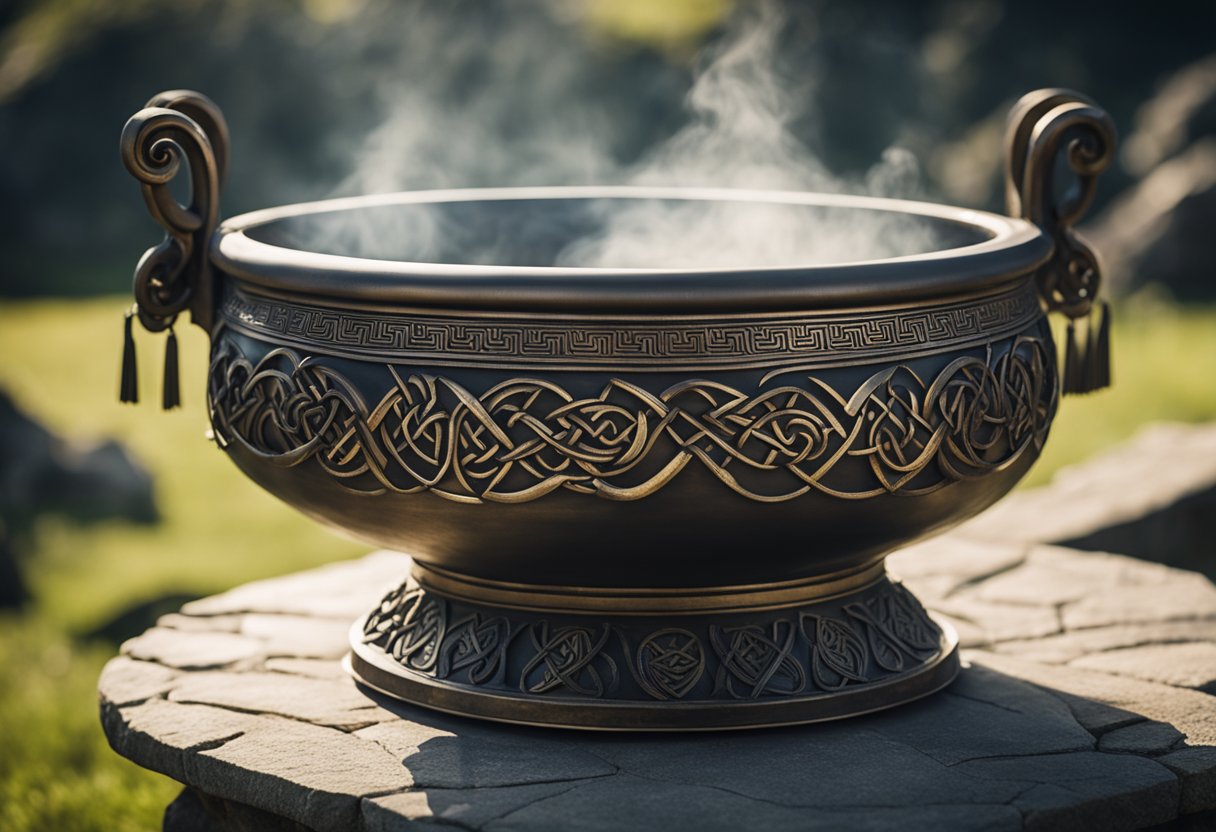
Updated On: April 24, 2024 by Eman Sameh
In Irish and Celtic mythology, the magisterial figure of the Dagda stands out as a deity of immense power and authority. As a prominent member of the Tuatha Dé Danann, a pantheon celebrated for their supernatural talents and significant influence, Dagda emerges as a father figure and protector, endowed with abilities that far surpass the ordinary. Among his fabled possessions, Dagda’s Cauldron epitomises the concept of endless plenty, a magical object said never to run dry. This item not only illustrates the theme of abundance and providence in mythological narratives but also symbolises the cultural and spiritual wealth of the ancient Celts.
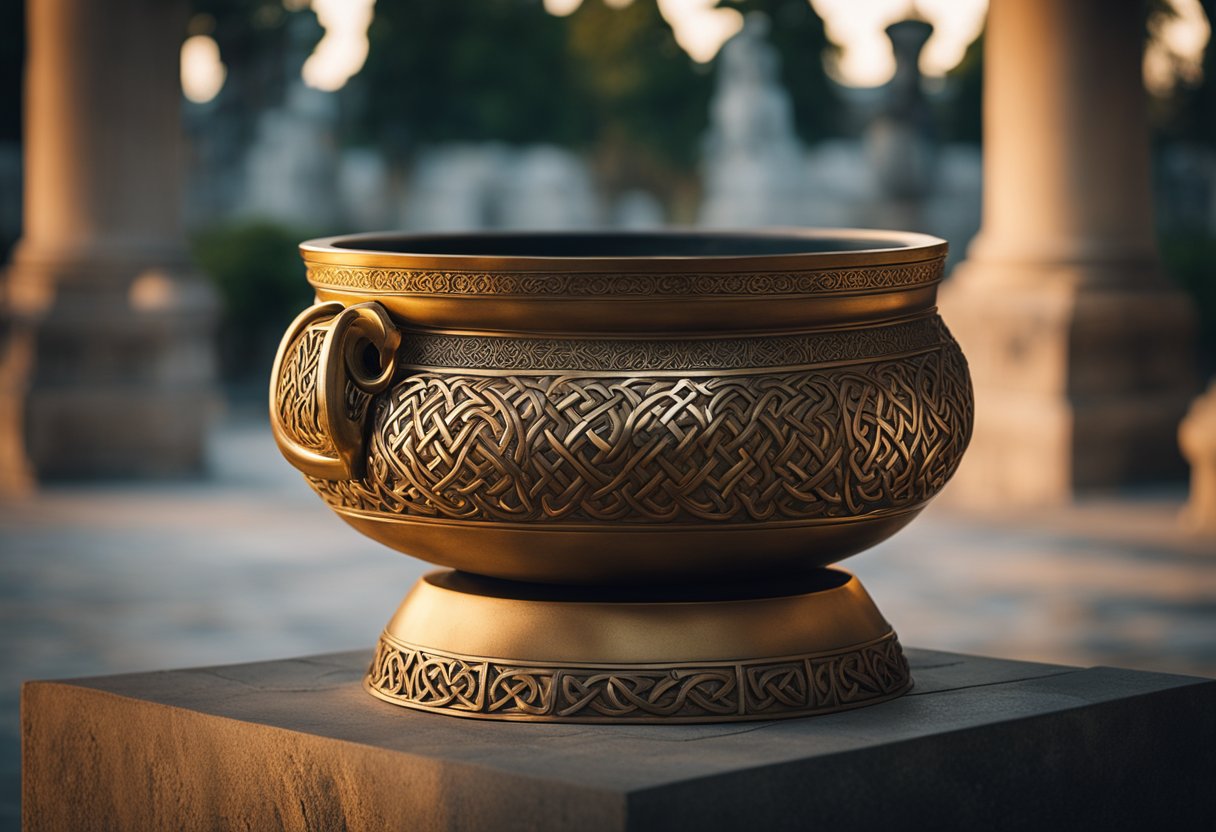
The artefacts of the deities are critical motifs in the tapestry of mythology, embodying various aspects of life and nature. Dagda’s Cauldron, alongside his club and harp, comprises part of his legendary arsenal, each imbued with extraordinary attributes. These enchanted items reflect the Dagda’s domains of fertility, wisdom, and abundance and are often depicted in tales that interweave the earthly and the divine. Within the context of social and celestial order, such mythological objects play pivotal roles in shaping the cosmos of Celtic belief, incidentally highlighting the interconnectedness of life and the cosmos according to ancient perspectives.
The Mythological Significance of Dagda
In the rich tapestry of Irish mythology, the Dagda holds a prestigious position as a leader and a protector, embodying wisdom, abundance, and fatherly authority within the pantheon of the Tuatha Dé Danann.
Dagda’s Role in Irish Legends
The Dagda, also known as Eochaid Ollathair, is a central figure in Irish legends, revered for his profound wisdom and strength. He is one of the Tuatha Dé Danann, the tribe of gods that once ruled Ireland, and his influence is woven deeply into the narratives at Brú na Bóinne. As the custodian of the Four Treasures of the Tuatha Dé Danann, his prowess in battle and governance was unmatched.
The Dagda as a Father God
Renowned as a Father God, the Dagda oversees the well-being and order of the family of deities. His children, including Aengus, Brigid, and Aine, are significant deities themselves, reflecting various aspects of life such as love, craftsmanship, and summer’s warmth. The Dagda’s relationship with Boann, his consort and fertility goddess, further defines his paternal and procreative attributes.
Associations with Fertility and Abundance
The Dagda’s association with fertility extends beyond familial lines to encompass the enrichment of the land itself. He is intrinsically linked to the cycles of life and death, ensuring the fertility of the fields and the well-being of the people. The cauldron, one of his famed possessions, symbolises endless sustenance and abundance, underlining his role as a provider. His liaisons, particularly with the Morrigan, symbolise the union of sovereignty and the land, integral to the prosperity and protection of the territory.
In our portrayal of the Dagda, we capture the essence of a figure who is not only a mighty warrior and sagacious leader but also a nurturing presence in Irish mythology. His depiction of legends showcases the reverence with which fertility, wisdom, and guardianship are viewed within Ireland’s cultural heritage.
Dagda’s Cauldron: A Symbol of Bountiful Provision
In our exploration of mythological artefacts, we must acknowledge Dagda’s Cauldron as a quintessential emblem of prosperity. This mystical cauldron, woven deeply into the fabric of Irish lore, was a container of infinite sustenance and a symbol of the cyclical flow of nature’s bounty.
The Cauldron’s Mythical Powers
We find that Dagda’s Cauldron, also known as Coire Ansic, was renowned for its incredible magic. No company ever left it unsatisfied, for it had the endless capability to provide nourishment. Such was the cauldron’s power to restore life, marking it as an instrument of both sustenance and resurrection. This vessel was envisaged as a font of ceaseless resources, a pivotal item in the pantheon of Celtic mythology where abundance and sustenance intersected with the mystical.
Symbolism in Celtic Beliefs
For us, the symbolism of the cauldron is deeply entrenched in Celtic beliefs. It represents an inexhaustible source of knowledge and inspiration, closely linked to the concept of the Cauldron of Plenty. The cauldron captures the essence of the natural world’s fruitful provision and the ancient Celts’ reverence for the continuous provision found in nature. This symbol of abundance aligns with magic and knowledge, suggesting that understanding the natural world’s rhythms is both a bountiful and sacred pursuit.
The Dagda’s Enchanted Artefacts
In our exploration of the mythological figures of ancient Ireland, few are as compelling as the Dagda, whose enchanted artefacts are legendary. Among these wondrous items, his harp, Uaithne and the mighty club, Lorg Mór, stand as testaments to his power and skill.
The Living Harp Uaithne
The Harp Uaithne, often called the Magic Harp, was a symbol of the Dagda’s sovereignty and a testament to his role as a leader among the Tuatha Dé Danann. This extraordinary instrument could control human emotions and change the seasons by playing itself at its owner’s command. The Dagda’s harp not only emanated exquisite music but also had life breathed into it, causing it to leap to the Dagda’s hand when summoned.
The Mighty Lorg Mór
The Lorg Mór, sometimes referred to as a great club or staff, was one of the Dagda’s most formidable weapons. It was famed for its duality; with one end, the Dagda could bestow life, and with the other, he could take it away. The Lorg Mór was also said to be so large that the Dagda had to transport it on wheels. This mighty club was one of the sacred treasures that underscored his authority over life and death, acting as a protector and providing the Dagda with immense power.
Celtic Festivals and Dagda’s Role
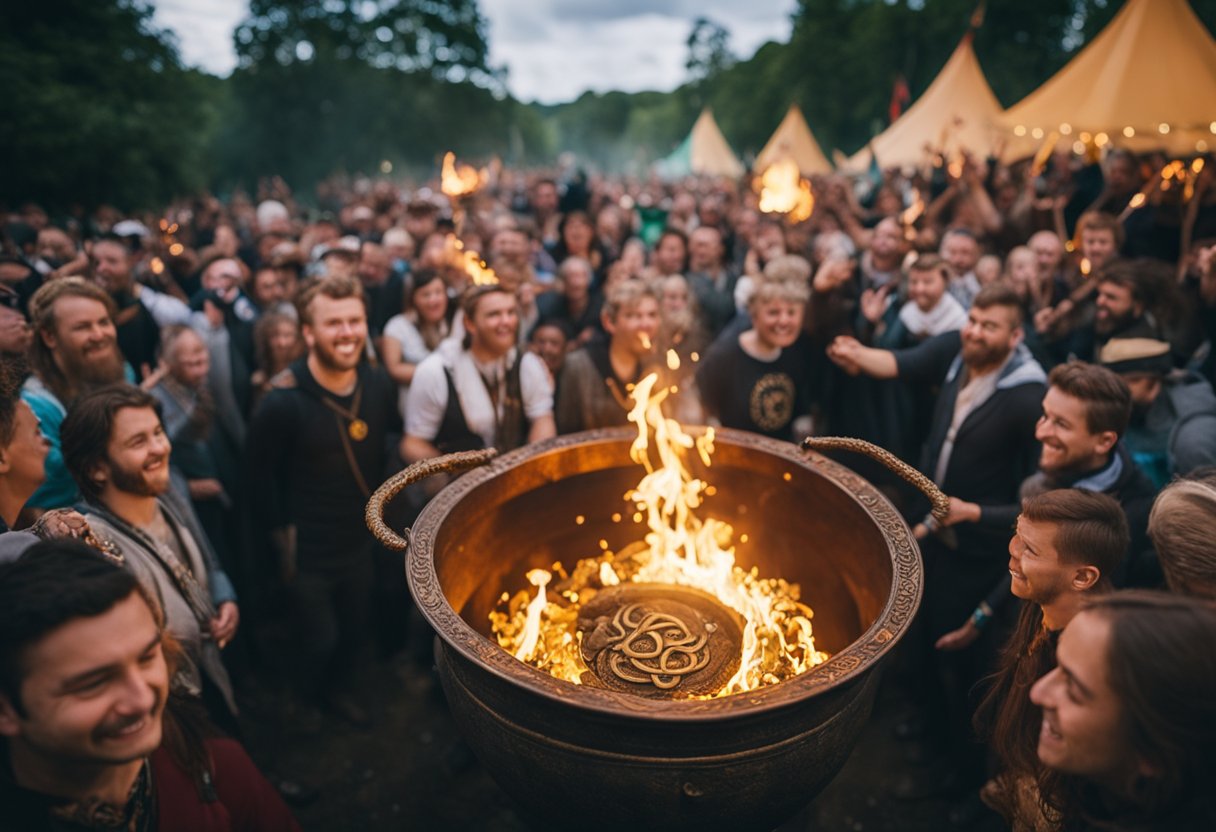
In the rich tapestry of Celtic mythology, the Dagda occupies a central role during seasonal festivals, particularly Samhain. His attributes are linked to the cycle of life, agriculture, and communal celebrations.
Samhain and the Dagda’s Feast
Samhain marks the end of the harvest season and the beginning of winter. Regarded as a time when the veil between our world and the Otherworld is thinnest, Samhain is a period rife with mystical potential and festivity. The Dagda, known for his bounteous cauldron, is celebrated as a provider of endless sustenance. As communities come together, the consumption of specially prepared porridge embodies both ritualistic and practical significance, ensuring the community’s survival through the dark, lean months ahead.
During Samhain, it was believed that the Dagda’s cauldron, one of the four legendary treasures of the Tuatha Dé Danann, would never let anyone go unsatisfied, symbolising a promise of rebirth and sustenance for all.
Other Notable Rituals and Celebrations
Aside from Samhain, the Dagda’s role extends to other festivals and ceremonies throughout the Celtic calendar. His connection to agriculture casts him as a protector and benefactor during planting and harvesting rituals, coinciding with various seasonal celebrations. These festival times were opportunities for communities to engage in shared rituals that honoured the cycles of nature.
The mythological implications of Dagda resonated deeply with the rhythm of seasonal change and the lifecycle of agriculture, reinforcing his status as a god intimately tied to society’s well-being and prosperity.
The Tuatha Dé Danann and Peer Deities
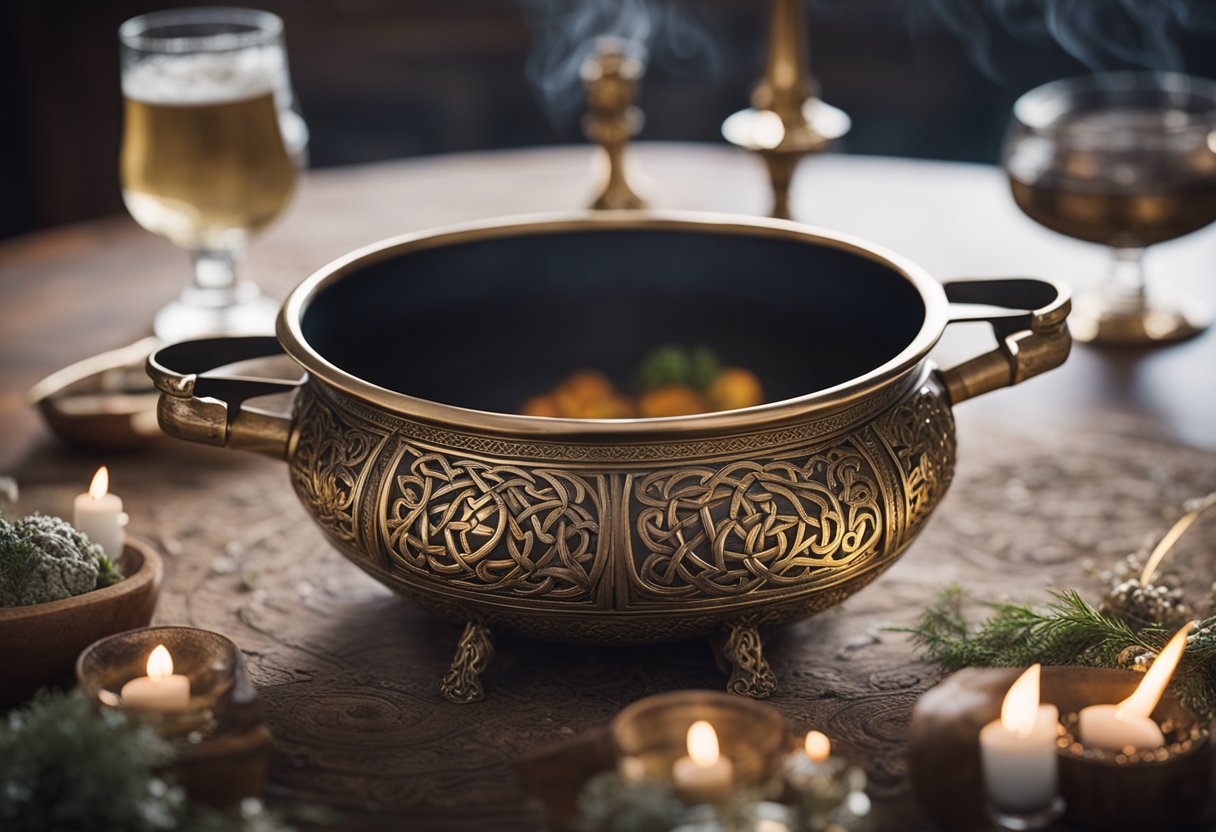
In the tapestry of Irish mythology, the Tuatha Dé Danann hold a central thread interwoven with relationships and conflicts among various divine beings. Their sagas reveal the complexities of deific diplomacy and warfare.
Relationships with Other Deities
We see the Tuatha Dé Danann engage in a complex network of relationships with other deities, ranging from familial bonds to rivalries. For instance, Brigid, a goddess revered for her wisdom and creativity, is also known for her healing, poetry, and smithcraft, embodying the multifaceted interests of her kin. The Morrígan, a deity of battle and sovereignty, often crossed paths with the Tuatha Dé Danann, influencing war and fate. Manannan, the master of the seas, and Midir, associated with the underworld and wealth, are other notable deities showcasing the breadth of the Tuatha Dé Danann’s reach into various domains.
Battles and Alliances
The Fomorians, a group of malevolent beings, frequently clashed with the Tuatha Dé Danann, leading to legendary battles that shaped the cosmos. In particular, the Second Battle of Mag Tuired was a defining moment, with Bodb Derg and The Dagda, the father-figure deity associated with abundance and wisdom, playing significant roles. Tactical alliances with deities of the elements, such as those controlling weather, were crucial for the Tuatha Dé Danann’s victories, further exemplifying the strategic and interconnected nature of their divine kinship.
Mythological Battles and Dagda’s Role
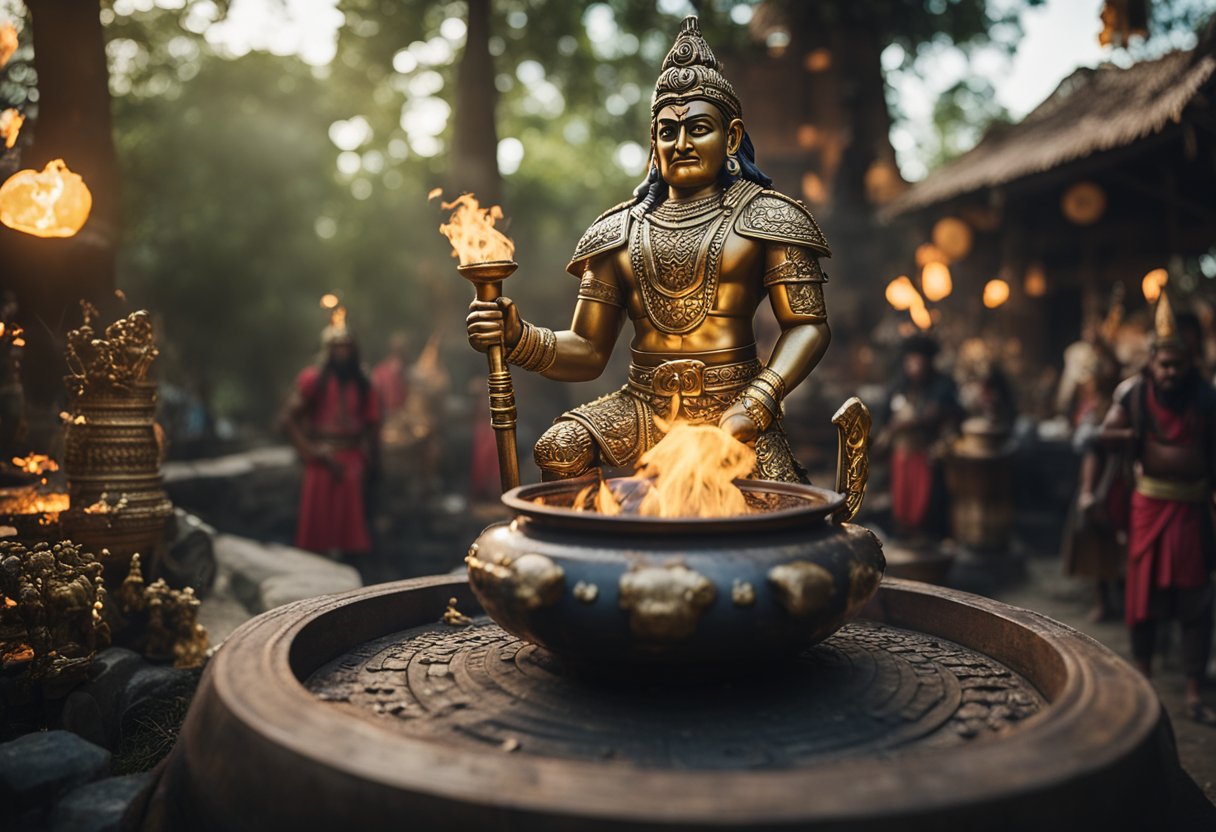
In ancient Irish mythology, the Dagda is a formidable figure whose presence was pivotal in legendary battles. With his mighty club and wisdom, he was a cornerstone in the conflicts against the Fomorian forces.
The Fomorian Conflicts
The Fomorians, a supernatural race, posed a significant threat to Ireland. Acting as both a warrior and a father figure, the Dagda was instrumental in these conflicts. He wielded a giant club that was so heavy, it required a wheeled chariot to transport. Yet, with one end, he had the power to slay the living and, with the other, to bring them back to life. This unique tool and his strategic mastery saw him become a linchpin in the defence against the Fomorian menace.
The Second Battle of Mag Tuired
A significant confrontation between the Tuatha Dé Danann, of which the Dagda was a chief, and the Fomorians was the Second Battle of Mag Tuired. This decisive battle marked the prowess of the Dagda not just as a warrior but as a stabilising force. As the Tuatha Dé Danann rallied under leaders like Nuada and Lugh, the Dagda’s role transcended the battlefield, dealing with the metaphysical aspects of war well beyond mere combat. During this battle, the feared Fomorian leader Balor was ultimately defeated, signalling both a tactical and symbolic victory for the Tuatha Dé Danann.
Our recounting of these mythological battles underscores the Dagda’s integral role as a protector with profound strength, wisdom, and the intricate interplay between life and death—a true force to be reckoned with amidst the chaos of ancient lore.
Legends of Love and Affair
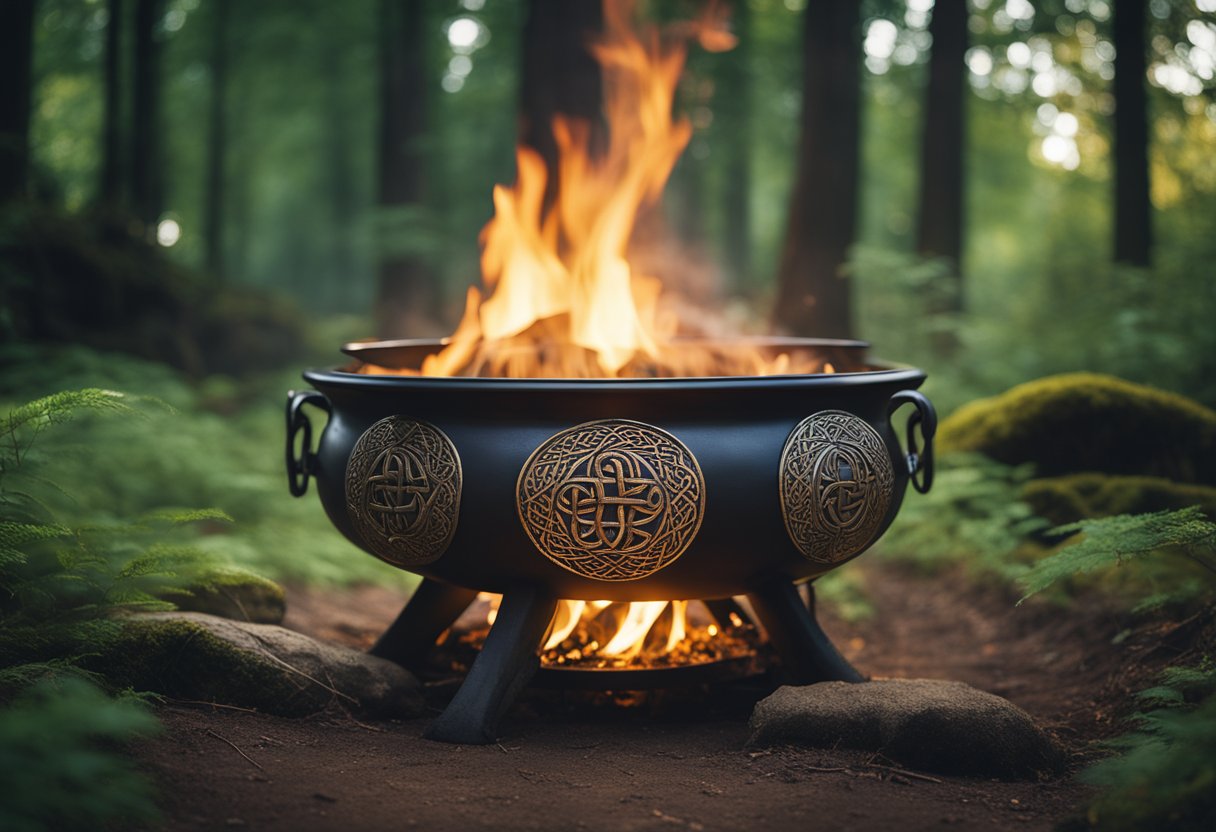
The Dagda’s romantic exploits reveal as much about his power as they do about the complexity of love and affairs in the mythological tapestry. These relationships, often intertwined with his magical cauldron, reveal The Dagda’s influence and connections with other deities.
Dagda and the River Goddess
The Dagda, often acknowledged as an All-father figure within the pantheon of Irish mythology, once engaged in a consequential liaison with the river goddess, Boann. This affair resulted in the birth of their son, Aonghus. Boann, the wife of Elcmar, was enchanted by the Dagda’s power and presence. To conceal their affair, The Dagda stopped the sun’s movement, making it a day last nine months, which allowed Aonghus to be conceived and born in a single day.
Encounters with Cermait and Others
Our sagas recount The Dagda’s encounter with the goddess Morrigan, where an exchange of favours led to an intimate union on the eve of the battle. Their liaison promised victory for The Dagda and his people. These connections showcase The Dagda’s strategic use of love and affection as potent tools within the divine realm.
Furthermore, in asserting his dominance, The Dagda avenged the death of his son, Cermait, who was killed after engaging in his own affair with the wife of the god Midir. These tales encapsulate the intertwining of love, desire, and power within mythology, illustrating the significance of passion in ancient narratives.
Cosmology and the Otherworld in Celtic Belief
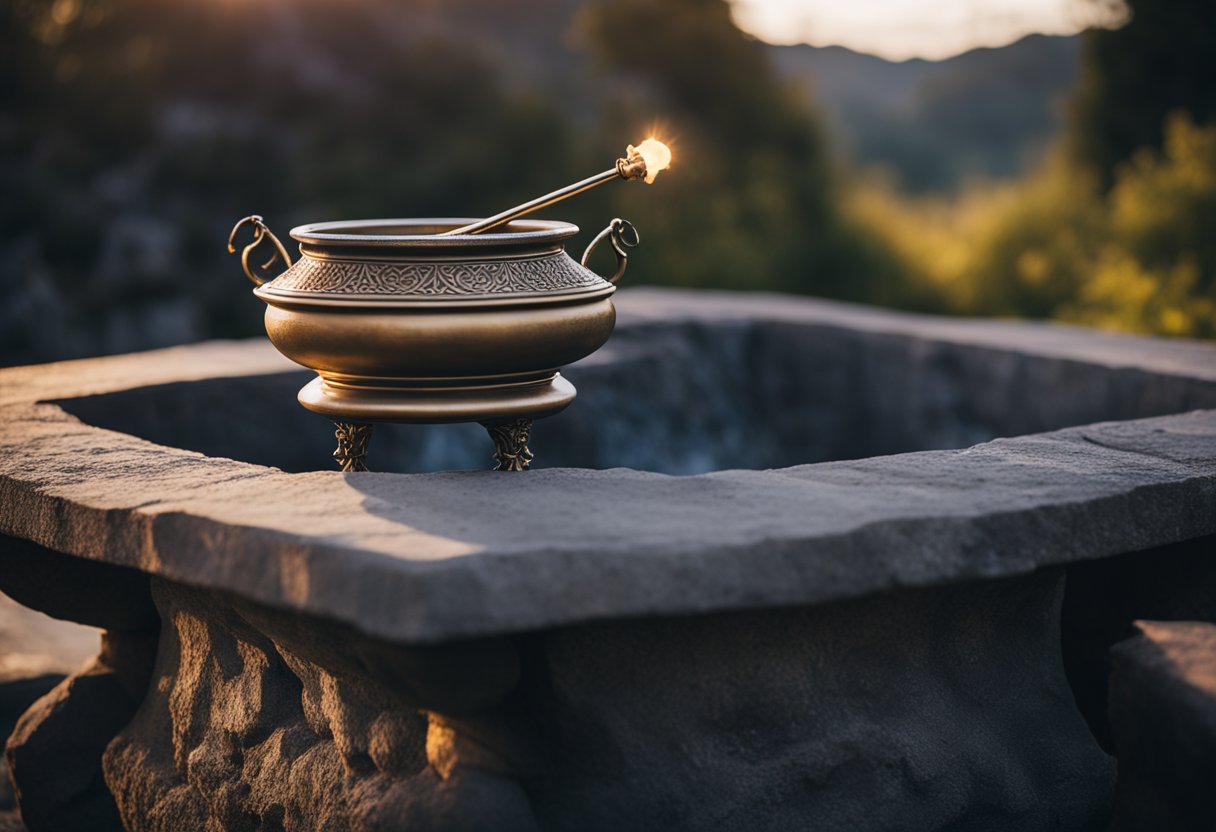
In the rich tapestry of Celtic mythology, the Otherworld and celestial bodies play integral roles, especially in relation to the enigmatic deity Dagda and the significance of ancient sites such as Newgrange and Brú na Bóinne.
Dagda’s Connection to the Afterlife
In our understanding of Celtic cosmology, the Dagda is a pivotal figure. As the chief deity of the Tuatha Dé Danann, his influence extends beyond the physical realm; he is deeply entwined with the Otherworld—a realm of eternal youth, beauty, and happiness. The Dagda’s Cauldron, a symbol of abundance and the divine, is not merely a vessel but also represents the cyclical nature of life, death, and rebirth, accentuating his association with the afterlife and regeneration.
Elatha, his father, further cements the mystical connection by being one of the Fomorians renowned for their magic and otherworldly prowess. The stories tell of interactions between these beings and our world, with the Dagda symbolising the bridge between mortals and the divine Otherworld.
Relevance of Newgrange and Brú na Bóinne
Newgrange and Brú na Bóinne stand as testaments to Druidry and celestial knowledge within Celtic Mythology. Newgrange, in particular, is believed to align with the winter solstice, when the sun illuminates its inner chamber. This spectacular event highlights the ancient Celts’ deep understanding of astronomy and reverence for the cycle of the seasons.
As such, these monuments exemplify the physical manifestation of their cosmological beliefs. Brú na Bóinne is called the ‘palace’ of the Dagda, reinforcing its inalienable link with the divine and the Otherworld.
These sites also reflect the Celts’ interpretation of the world’s construction—where realms of the sky, land, and sea intertwine—and the importance placed upon certain numbers, such as the triad, within their cosmological framework.
Through our exploration of these rich cultural narratives, we appreciate the profound symbolic significance of these mythological objects and places in ancient Celtic belief systems.
Historical Texts and the Preservation of Dagda’s Myths
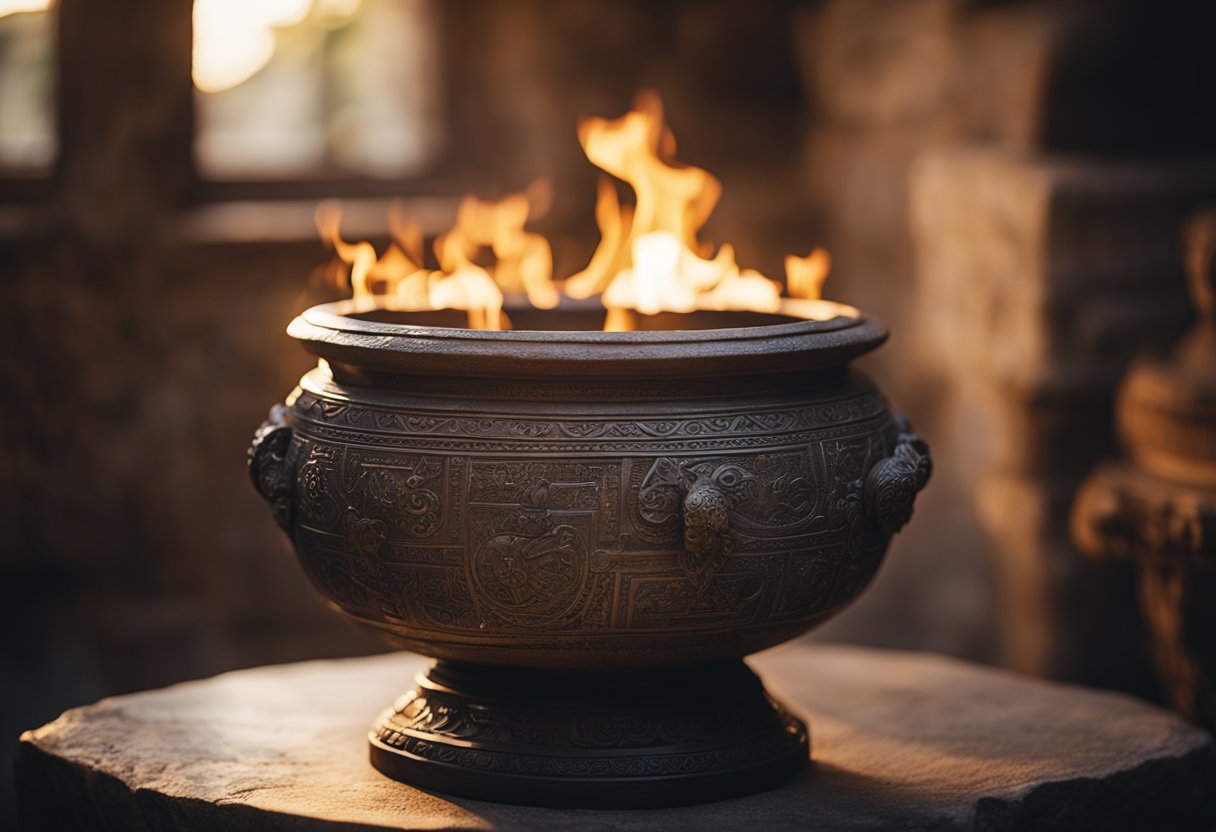
Exploring Dagda’s Myths reveals the vibrant tapestry of Irish mythology preserved through historical manuscripts and the study of the language’s origins.
Lebor Gabála Érenn and Annals
Lebor Gabála Érenn, often referred to as the Book of Invasions, is a seminal piece of Irish literature that narrates Ireland’s mythological history. It weaves together the tales of numerous mythological figures, including the Dagda, and recounts the magical deeds and happenings associated with them. The Dagda, known for his mighty cauldron of abundance, is a prominent figure within these chronicles.
The Annals, records like the Annals of the Four Masters, further solidify these myths, detailing the lineages and deeds of Celtic gods and heroes in a historical format. These texts serve as crucial vessels, ensuring that the mythological significance of figures like the Dagda remains ingrained in our cultural consciousness.
Proto-Celtic Sources and Etymology
Delving into Proto-Celtic sources, we find the linguistic roots that give rise to the names and attributes of figures such as the Dagda. Linguists have established that the term ‘Dagda’ is believed to derive from the Proto-Celtic “Dagodeiwos”, translating into “the good god” or “great god”. This etymological foundation informs our understanding of his perceived role and significance within the Celtic pantheon.
The Coir Anmann (Fitness of Names), a glossary of Irish names, further illuminates the connections between the characters’ names and their mythological attributes. As we parse through these ancient texts and etymological evidence, our comprehension of the Dagda and his cauldron deepens, shedding light on the revered status bestowed upon him in the Celtic lore.
The Dagda’s Legacy in Modern Culture

The Dagda’s presence in modern culture is discernible through various adaptations and interpretations that resonate with contemporary audiences. His mythological significance extends beyond ancient tales, permeating literature, art, and neopagan practice today.
Influence on Literature and Art
The Dagda, an esteemed figure in Irish mythology, has become a source of inspiration for numerous works of literature and art. His depiction frequently embodies the archetypal wise ruler, imbued with druidic knowledge and magical prowess. Authors and artists often draw upon the rich tapestry of Dagda’s lore to explore themes of power, providence, and the natural world.
Fantasy literature, in particular, borrows elements from his tales, seeing characters mirror Dagda’s leadership and paternal wisdom attributes. Artistic representations have also evolved, with modern illustrations and sculptures providing a contemporary visual narrative that pays homage to this deity’s influential Cultural Impact.
Contemporary Representations of Dagda
In modern interpretations of paganism, particularly within the neopagan communities, the Dagda is revered for his robust connection to Earth and as the archetypal fatherly deity. His attributes, from the control over life and death to the governance of seasons, make him a figure of great reverence in festivals and rituals that aim to connect with the natural and spiritual world.
Dagda’s Cultural Impact has also infiltrated pop culture, with television, music, and film references often displaying his iconic symbols, such as the cauldron and club. His essence influences characters that channel earthly wisdom and life-giving power, showing the enduring resonance of this storied figure in our collective consciousness.
Through these mediums, Dagda’s legacy is carried forward, illustrating the enduring nature of mythological figures in shaping and enriching Modern Interpretations of culture.
Frequently Asked Questions
In our exploration of mythological objects, Dagda’s Cauldron stands out for its intriguing attributes and the rich stories that surround it. Let’s address some of the most common enquiries about this enigmatic artefact.
What are the hallmarks of Dagda’s representation in mythology?
Dagda is revered as a pre-eminent figure in Irish mythology known for his exceptional skills and attributes. His magical staff, harp, and abundant cauldron symbolise his mastery and prowess, epitomising his role as protector and provider.
How does the narrative of Dagda and Morrigan unfold?
The narrative between Dagda and Morrigan is captivating, depicting a complex relationship. It includes a strategic alliance on the eve of the battle against the Fomorians, where Dagda secures Morrigan’s support, which is crucial for the victory of the Tuatha Dé Danann.
In what ways are Dagda and Odin depicted similarly or differently in their respective mythologies?
Dagda and Odin share similarities in their roles as gods of wisdom and war. While Odin roves through Norse myths as a seeker of knowledge, often through sacrifice, Dagda portrays him as a father figure with abundant provisions and wisdom that sustains his people.
What role does the cauldron play within the larger context of Celtic myths?
The cauldron in Celtic myths, particularly Dagda’s, is emblematic of unending prosperity and regeneration. Steeped in mystery, it provided endless sustenance, reflecting the Celts’ value of hospitality and abundance.
Can you elucidate the meaning behind the cauldron symbol in relation to the Dagda?
The cauldron, Dagda’s attribute, signifies not just physical nourishment but also spiritual and intellectual sustenance. It’s a potent symbol of life’s cyclical nature, encompassing birth, death, and rebirth.
Who is considered to be the consort of the Dagda in mythological tales?
The Morrigan is often recognised as a consort of the Dagda, their union representing a confluence of sovereignty and fertility within the ancient Irish pantheon of deities.






